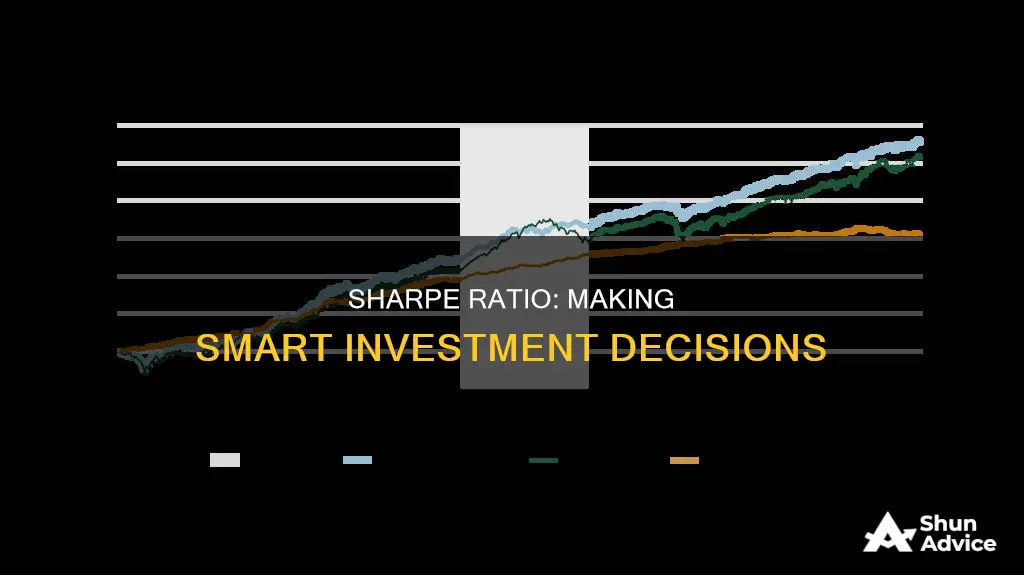
The Sharpe ratio, named after its creator, William F. Sharpe, is a financial metric that helps investors understand the return of an investment compared to its risk. It is a measure of the risk-adjusted return of a financial portfolio and is used to help investors understand the return of an investment compared to its risk. The Sharpe ratio can be used to evaluate the total performance of an investment portfolio or the performance of an individual stock. It is calculated by subtracting the risk-free rate of return from the expected rate of return, then dividing the resulting figure by the standard deviation. A higher Sharpe ratio indicates better performance, with a ratio of 1 or above considered good, 2 very good, and 3 excellent. The ratio is useful for long-term investments but not for short-term traders.
| Characteristics | Values |
|---|---|
| What it is | A financial metric that shows how an investment is performing relative to its risk |
| Who it's for | Hedge funds, investment managers and everyday investors |
| What it measures | The return of an investment compared to its risk |
| When to use it | When comparing similar investments, like mutual funds and ETFs that track the same underlying index |
| How to calculate it | Subtract the risk-free rate of return from the expected rate of return, then divide the resulting figure by the standard deviation |
| Interpreting the ratio | A ratio of 1 or better is good, 2 or better is very good, and 3 or better is excellent |
| Benefits | Standardises the relationship between risk and return, making it easier to compare different classes of assets |
| Limitations | It assumes a normal distribution of returns and doesn't take into account returns fluctuations |
What You'll Learn

Understanding the Sharpe ratio
The Sharpe ratio is a financial metric that helps investors understand the return of an investment compared to its risk. It was developed by economist William F. Sharpe in 1966 and is named after him. Sharpe won the Nobel Prize in Economic Sciences in 1990 for his work.
The Sharpe ratio is calculated by subtracting the risk-free rate of return from the expected rate of return, then dividing the resulting figure by the standard deviation. The risk-free rate of return is typically the rate of return on a risk-free investment, such as US government treasury bonds or bills. The standard deviation is a measure of volatility and risk.
The Sharpe ratio is a useful tool for investors as it provides a quick analysis of how investment risk is paying off based on returns. It can be used to evaluate either an individual asset or a portfolio of assets and can be calculated using historical or expected returns.
A higher Sharpe ratio indicates better investment performance given the risk. A ratio of 1 or more is considered good, a ratio of 2 or more is very good, and a ratio of 3 or more is excellent. A Sharpe ratio of less than 1 is considered sub-optimal or bad.
The Sharpe ratio has some limitations. It assumes a normal distribution of returns, which is not always the case in practice. It also does not take into account returns fluctuations as the standard deviation remains the same regardless of the environment in which returns fluctuate. Additionally, the Sharpe ratio is not useful for short-term traders as it is designed to analyse long-term investments.
Despite these limitations, the Sharpe ratio is a widely used tool for measuring risk-adjusted returns and making more informed investment decisions.
Tech Giants Eyeing India: Where's the Investment Focus?
You may want to see also

Comparing investment opportunities
The Sharpe ratio is a useful tool for comparing investment opportunities. It measures the performance of an investment, such as a security or portfolio, against a risk-free asset, while also taking into account the level of risk. This allows investors to make more informed decisions by considering both returns and risk.
The Sharpe ratio is calculated by subtracting the risk-free rate of return from the expected rate of return, and then dividing that figure by the standard deviation of the portfolio or investment. The higher the Sharpe ratio, the better the investment's returns relative to the amount of risk taken.
For example, consider two investment managers. Manager A generates a return of 15% and Manager B generates a return of 12%. On the surface, Manager A appears to be the better performer. However, if Manager A took on larger risks than Manager B, then Manager B may have generated a better risk-adjusted return.
Let's assume that the risk-free rate is 5% and Manager A's portfolio has a standard deviation of 8%, while Manager B's portfolio has a standard deviation of 5%. In this case, Manager A would have a Sharpe ratio of 1.25, while Manager B's ratio would be 1.4, indicating that Manager B generated a higher return on a risk-adjusted basis.
The Sharpe ratio can also be used to compare different types of investments, such as shares, ETFs, mutual funds, and investment portfolios. For instance, an investor could use the Sharpe ratio to assess the risk-adjusted returns of two potential portfolios or their individual component assets.
It is important to note that the Sharpe ratio has some limitations. It assumes that returns are normally distributed, but in practice, many investment strategies can create distributions of returns that are not perfectly symmetrical. Additionally, the Sharpe ratio does not take into account fluctuations in returns, as the standard deviation remains the same regardless of the environment. Therefore, it is important for investors to consider these limitations when evaluating investment opportunities using the Sharpe ratio.
Equity Investment Benefits: Why You Should Invest in Equity
You may want to see also

Evaluating performance
The Sharpe ratio is a useful tool for evaluating the performance of an investment or portfolio. It helps investors understand how well their investments are doing relative to the risk they are taking. The ratio is calculated by subtracting the risk-free rate of return from the expected rate of return, and then dividing that result by the standard deviation (the volatility of the portfolio's returns). This gives investors a standardised measure of the risk-adjusted return of their investments.
A higher Sharpe ratio indicates better performance, as it means that the investment is generating higher returns relative to the risk taken. A ratio of 1 or above is generally considered good, with a ratio of 2 or above considered very good, and a ratio of 3 or above considered excellent. Conversely, a ratio below 1 is considered sub-optimal or bad, indicating that the risk associated with the investment is not being sufficiently offset by the returns.
The Sharpe ratio can be used to compare the performance of different investments or portfolios. For example, an investor could use it to assess the risk-adjusted returns of two potential portfolios or their individual component assets. It can also be used to evaluate the performance of an existing portfolio and identify potential changes that could improve its risk-adjusted returns. For instance, adding assets with higher Sharpe ratios to a portfolio may increase its overall risk-adjusted returns.
The Sharpe ratio is particularly useful for long-term investments and is widely used by hedge funds and investment managers to maximise returns for their clients without taking on excessive risk. However, it has some limitations. One criticism is that it assumes a normal distribution of returns, which may not always be the case in practice. Additionally, the Sharpe ratio does not take into account returns fluctuations, as the standard deviation remains the same regardless of the environment in which returns fluctuate. It is also sensitive to the choice of the risk-free rate used in the calculation, which may vary depending on the benchmark selected.
India's Space Exploration: Worth the Investment?
You may want to see also

Ranking risk
The Sharpe ratio is a useful tool for investors to evaluate the risk-adjusted performance of an investment. It measures the additional amount of return that an investor receives per unit of increased risk. A higher Sharpe ratio indicates a higher investment return relative to the risk of the investment. For example, a ratio of 3.0 or higher is considered excellent, while a ratio under 1.0 is considered sub-optimal.
The ratio is calculated by subtracting the risk-free rate of return from the expected rate of return and then dividing that result by the standard deviation. The risk-free rate of return is typically the shortest-dated government T-bill, while the standard deviation measures the total risk or volatility of the investment.
By ranking investments based on their Sharpe ratios, investors can make more informed decisions by considering both returns and risk. It is important to note that the Sharpe ratio has some limitations, such as the assumption of a normal distribution of returns, and it may not capture all aspects of risk. Therefore, it should be used in conjunction with other tools and analyses for a comprehensive understanding of investment risk.
ERP Modules: Unlocking Investment Management Potential
You may want to see also

Planning hedging strategies
The Sharpe ratio is a key metric in the world of finance, used to measure the performance of an investment relative to its risk. It helps investors understand the return of an investment compared to its risk, and whether they are being adequately compensated for taking on additional risk.
When planning hedging strategies, investors can use the Sharpe ratio to decide which assets they want to hold and protect themselves against potential losses. This is particularly useful when comparing similar investments, such as mutual funds and ETFs tracking the same underlying index.
Step 1: Understand the Sharpe Ratio Formula
The Sharpe ratio formula is as follows:
Sharpe Ratio = (Expected Portfolio Return - Risk-Free Rate of Return) / Standard Deviation of Portfolio Return
- The expected portfolio return is the anticipated return on an investment portfolio or individual stock.
- The risk-free rate of return is the return on a risk-free investment, such as government treasury bonds or bills.
- The standard deviation of the portfolio return is a measure of the volatility or risk of the investment.
Step 2: Calculate the Sharpe Ratio for Different Investments
Apply the Sharpe ratio formula to the investments you are considering for your portfolio. This will give you a numerical value that indicates the risk-adjusted return of each investment.
Step 3: Analyse the Results
Compare the Sharpe ratios of the different investments. A higher Sharpe ratio indicates a more attractive risk-adjusted return.
Step 4: Decide on Hedging Strategies
Based on the analysis, decide which assets you want to hold in your portfolio. For example, if you are risk-averse, you may choose investments with higher Sharpe ratios, indicating better returns relative to the risk.
Step 5: Monitor and Adjust
Remember that the Sharpe ratio is not static and can fluctuate over time as the risk-free rate of return, expected rate of return, and standard deviation change. Regularly review the Sharpe ratios of your investments and adjust your hedging strategies as needed.
By following these steps, you can use the Sharpe ratio to make informed decisions about which assets to hold and how to protect yourself against potential losses, ultimately improving your investment portfolio's performance.
Stockholder Investment: Is It Really Equity?
You may want to see also
Frequently asked questions
The Sharpe ratio is a financial metric that measures the performance of an investment, such as a security or portfolio, compared to a risk-free asset, while also adjusting for its risk. It was created by William F. Sharpe in 1966 and is calculated by subtracting the risk-free rate of return from the expected rate of return, then dividing the resulting figure by the standard deviation.
A higher Sharpe ratio indicates better investment performance given the risk. A ratio of 1 or above is generally considered good, 2 or above is very good, and 3 or above is excellent. A ratio under 1 is considered sub-optimal.
The Sharpe ratio is a widely used metric that helps investors understand the return of an investment compared to its risk. It can be used to evaluate the performance of individual stocks or entire portfolios, and it is especially useful for comparing similar investments.
The Sharpe ratio assumes that asset returns are normally distributed, but in reality, many financial institutions use investment strategies that create distributions of returns that are not perfectly symmetrical. It is also not very useful for short-term traders as it is designed for analysing long-term investments.







